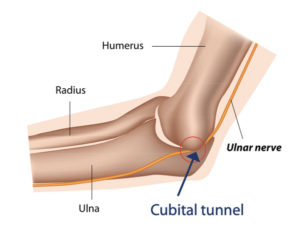05 Jun How to Address Cubital Tunnel – Practical Expert Advice
This past weekend I had a neighborhood gathering and was approached by five different people complaining about the same thing! “What causes my small and ring fingers to tingle when I’m holding my cell phone; a book or tablet; or reading or sleeping?”
I started to realize so many people often experience “tingling” or “numbness,” and somehow just accepts it. At my weekend gathering, every one of them had been experiencing the symptoms for at least six months and had never mentioned it to their doctors, thinking it was merely a part of the aging process. It was a great opportunity for me to educate my neighbors on what exactly their symptoms may be caused by; offering a brief but comprehensive anatomy review to guide them in understanding the etiology of the tingling. This, of course, rolled right into a perfect segue of what I do as a Certified Hand Therapist (CHT).
 When I begin to explain that more than likely the sensations they were having in their ring and small fingers are probably stemming from an issue with the nerve in their elbow being compressed, I could see the look of disbelief – “how does a nerve in my elbow cause tingling down in my hand?” Without having any anatomy pictures to help explain I tried to find common ground by explaining the “funny bone.” I have found in my years of practicing in therapy that most people learn better with something they can visualize and relate to.
When I begin to explain that more than likely the sensations they were having in their ring and small fingers are probably stemming from an issue with the nerve in their elbow being compressed, I could see the look of disbelief – “how does a nerve in my elbow cause tingling down in my hand?” Without having any anatomy pictures to help explain I tried to find common ground by explaining the “funny bone.” I have found in my years of practicing in therapy that most people learn better with something they can visualize and relate to.
A path underneath the ‘funny bone” routes a delicate nerve called the ulnar nerve. The ulnar nerve passes through that boney ridge (the funny bone region) without any substantial padding to protect it. The nerve needs to be able to glide and stretch through that passage, which is called the cubital tunnel. Any motion in the arm itself causes some type of excursion or glide on the ulnar nerve. If for some reason the nerve gets compressed or pinched along its pathway from the neck to the fingers, it may cause pain, aching, tingling or numbness. Those symptoms can be felt anywhere along the path of the nerve and not always in the location of the compression as with Cubital Tunnel Syndrome.
Once everyone understood the basic anatomy and causes of the symptoms they were feeling, we discussed some practical home remedies that may help alleviate their symptoms. A big part of addressing nerve compression is education. Certified Hand Therapists often try to educate clients’ about when their symptoms occur so the client can self-assess what position the arm is in when the symptoms occur or worsen. This empowers the client to minimize their symptoms by modifying their arm and hand positions, so the nerve doesn’t compress. This includes switching between two hands when ‘on hold’ on the phone, changing arm position when sleeping (if you sleep with your elbow bent under your head), decreasing the amount of time you lean on the console of your car, and decreasing the amount of time you hold a tablet. These are just some of the basic home remedies individuals can incorporate into their lifestyle to help minimize their symptoms.
Chronic nerve compression can potentially lead to permanent damage to the nerve. It is important to let your doctor know about any tingling or numbness you’ve been experiencing, and provide a list of the positions that worsen or alleviate your symptoms. It is also important to report how long you’ve been experiencing symptoms.
Nerve compression symptoms; be it tingling, numbness, or pain, can all be treated through a good physician workup and with help and education from a Certified Hand Therapist aimed at controlling symptoms, and identifying specific exercises and lifestyle modification. Once the symptoms are managed properly, most patients can return to completing those daily tasks that once caused so much discomfort.
Everyone was encouraged to finally see their physicians and have the necessary medical workup and diagnostic testing, which is why I jump at any chance to share about my career as a Hand Therapist…although my husband isn’t always as excited to hear the familiar that he’s herd on so many occasions.
To learn more about cubital tunnel, read the American Society of Hand Therapists’ education guide on cubital tunnel syndrome.
 Article provided by
Article provided by
Kathy Baker, OT, CHT

